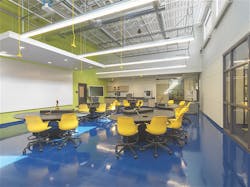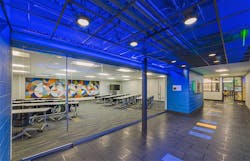In October 1957, the Soviet Union launched the Sputnik satellite into orbit, and leaders in the United States were forced to face the fact that the nation had been caught napping—not just by letting the Soviets get a jump on the Space Race, but by failing to provide the rigorous education that students needed to propel themselves into such lofty careers as rocket scientists.
The public uproar provoked by Sputnik not only led to the creation of a space program that would eventually carry U.S. astronauts to the moon, but it also prompted the nation’s educators and policy makers to turn their attention to beefing up science curriculum in schools.
Sixty years later, Sputnik has receded into the fog of memory as countless technological advances have revolutionized societies around the world, but the U.S. education system still struggles to produce enough students who are proficient in science, technology, engineering and mathematics.
The emphasis on science in schools has ebbed and flowed in the intervening years, and U.S. students still come up short in so-called STEM subjects compared with students from other nations.
In a fact sheet issued in December 2016 in the waning weeks of President Barack Obama’s administration, the White House asserted that computer science “remains largely missing from American K-12 education.”
“Just 40 percent of K-12 schools report offering even a single computer-science course,” the fact sheet said, “and only 32 states currently allow students to count computer science towards core high school graduation requirements.”
Progress has been slow even as the arguments for greater focus on science-related subjects have grown louder. The case is as persuasive as ever—even more so as technological skills become a fundamental element of the job market and daily life.
As STEM advocates continue their efforts to bolster science-related curriculum on K-12 and higher education campuses, many schools and universities are devoting more resources to STEM programs. Many also are working to design classrooms and provide other spaces that are more conducive to teaching and learning science-related lessons.
Playing Catch-Up
Since Sputnik shined a light on the deficiencies of U.S. schooling, educators and lawmakers have made efforts through the years to bolster science curriculum. But the pace of technological advances means that advocates of rigorous science curricula have had to chase a moving target, and decades later, they are still trying to catch up and produce students sufficiently trained in STEM fields to meet the needs of the modern economy.
Less than a year after Sputnik’s launch, lawmakers passed the National Defense Education Act. It increased federal funding for education at all levels, boosted college enrollment by making low-interest loans available to students, and placed special emphasis on scientific and technical education.
Conditions improved to some extent, but by 1983, U.S. leaders were still lamenting the gap between the science proficiency of the typical American student and what was needed to compete effectively in the global economy.
“Our once unchallenged preeminence in commerce, industry, science, and technological innovation is being overtaken by competitors throughout the world,” the National Commission on Excellence in Education said in “A Nation at Risk.”
Noting a steady decline in student achievement scores in science, the commission warned, “We are raising a new generation of Americans that is scientifically and technologically illiterate.”
“A Nation at Risk” again brought attention to deficiencies in U.S. education, and some reforms followed. By the 21st century, science advocates had a new acronym for their field—STEM—but the problems they cited echoed those articulated two decades earlier.
A committee formed by U.S. National Academies of Science, Engineering and Medicine, issued a 2005 report, “Rise Above the Gathering Storm,” that stated:
“The committee is deeply concerned that the scientific and technological building blocks critical to our economic leadership are eroding at a time when many other nations are gathering strength….Because other nations have, and probably will continue to have, the competitive advantage of a low wage structure, the United States must compete by optimizing its knowledge-based resources, particularly in science and technology.”
A 2012 report from the President’s Council of Advisors on Science and Technology pointed out that fewer than 40 percent of students who enter college intending to major in a STEM field complete a degree in that field.
“Many of those who abandon STEM majors perform well in their introductory courses and would make valuable additions to the STEM workforce,” the council’s executive summary states. “Retaining more students in STEM majors is the lowest-cost, fastest policy option to providing the STEM professionals that the nation needs for economic and societal well-being.”
Elements of STEM space
Developing and supporting robust STEM programs help schools and universities attract students to pursue studies in those fields, and providing facilities specifically designed to enhance the effectiveness of STEM instruction enables those students make the most of their educational opportunities.
That means flexible and inclusive learning spaces— in classrooms, makerspaces, in the natural world, or in natural environments,” says STEM 2026, a report from the U.S. Department of Education’s Office of Innovation and Improvement.
“The time is ripe for rethinking the space of the classroom,” STEM 2026 says, “including where and with whom STEM learning occurs, the role of work-based learning experiences in offering alternate spaces that can deepen understanding and content-knowledge in STEM, and how rapidly evolving technology can be leveraged to connect and empower students, educators, businesses, and communities in flexible and inclusive learning spaces.
EYP, an architectural firm that has designed several STEM-themed facilities on university campuses, issued a paper in 2016, “How Colleges & Universities Invigorate Campuses Through a New Genre of Stem Buildings,” that cites four major benefits from constructing or upgrading STEM-themed facilities:
- Increased student enrollment, retention, and interest in STEM programs.
- Improved faculty recruitment.
- Facility design that enhances teaching.
- Places where students can learn and become accustomed to a working environment that emphasizes team collaboration and interdisciplinary research.
EYP identified five key design elements that should be incorporated in spaces devoted to STEM education:
- Numerous “soft spaces”— lounges, alcoves and study areas—that lead to informal learning, collaboration, and chance encounters for students and faculty. “These spaces must offer students and teachers convenient places to interact with one another,” EYP says. “Without appealing and useful soft spaces in a STEM building, students and professors have far less incentive to remain in the building after classes or lab work are done.”
- Flexible laboratory spaces that promote hands-on, active learning methods, such as makerspaces, in which students can discover, digest and apply information, and which can be adjusted to accommodate different-sized groups.
- Reconfigurable classroom spaces where furniture can be moved, and workgroups created on the fly to provide options beyond lecture formats. “The cavernous, sloped lecture halls or chairs with flip-up desks of the not-so-distant past do not give professors the ability to teach in ways that require students to do more than just listen and take notes,” the paper says.
- Glass walls that put science and engineering activities on display and instill a heightened sense of community and collaboration. EYP says that more than half of the students who visit the science center at the College of the Holy Cross in Worcester, Mass., say that being able to see into labs through the glass walls inspired them to learn more about science.
- Innovative research labs that promote safe, efficient research and leading-edge research approaches. “Students reap efficiency and safety benefits when lab design prioritizes ease of reaching instruments and reproducing experiments,” the paper says. “Easily shareable lab space also encourages collaboration.”
Potential drawbacks
Working with institutions to provide better STEM facilities, EYP has identified three common barriers that schools should be prepared to face: faculty skepticism about the impact of building design on learning, worries about campus aesthetics, and cost.
“Not every faculty member believes in the value of interdisciplinary research or will want to share research space,” EYP says. “Thus, they may argue against interdisciplinary spaces.”
Kennedy, staff writer, can be reached at [email protected].
The Case for STEM: By the Numbers
Science advocates have been clamoring for years to persuade schools and universities to pay more attention to STEM education—long before the acronym gained hold among researchers and educators.
And like good scientists, they have compiled plenty of evidence to make the case that recruiting more students into STEM fields is vital to the nation’s economy and beneficial to students who take that path.
In a 2017 report, “STEM Occupations: Past, Present, and Future,” the U.S Bureau of Labor Statistics provided plenty of numbers to help demonstrate value of STEM education to employers, and the benefits it can provide for those who pursue studies in STEM fields.
The gist: The number of STEM-related jobs are increasing; they pay significantly more than non-STEM fields; and the workers that get those jobs need to have postsecondary education.
For instance:
- The United States had nearly 8.6 million STEM jobs in May 2015—which accounted for 6.2 percent of U.S. employment. Computer occupations account for 45 percent of STEM jobs (3,853,860 jobs) and engineers account for 19 percent (1,610,480 jobs).
- The national average wage for all STEM occupations was $87,570 a year—nearly double the national average wage ($45,700) for non-STEM occupations; for 93 of 100 STEM occupations, the wages received were above the national wage for all occupations ($48,320).
- Between 2009 and 2015, U.S. employment in STEM occupations grew by 10.5 percent (an additional 817,260 jobs), compared with 5.2 percent growth in non-STEM occupations. California added 160,950 STEM jobs in that period, and Texas added 102,190 STEM jobs.
- U.S. employment in computer occupations is projected to increase by 12.5 percent from 2014 to 2024—nearly a half-million new jobs.
- When the need to replace workers leaving their jobs is added to newly created jobs, there are projected to be more than a million job openings in computer occupations from 2014 to 2024.
- More than 99 percent of STEM jobs are in occupations that typically require some type of postsecondary degree—5 percent call for a doctoral or professional degree; 0.4 percent call for a master’s degree; 73.2 percent call for a bachelor’s degree; 14 percent call for an associate’s degree, and 6.8 percent call for some college without a degree. By comparison, 36 percent of U.S. jobs overall require some postsecondary education.
- States with higher shares of STEM occupations generally had higher wages. In Washington, D.C., 9.4 percent of the workforce were in STEM jobs, and the annual mean wage in 2015 was $80,150. In Mississippi, where 3.3 percent of the workforce held STEM jobs, the annual mean wage was $37,620. North Dakota, Tennessee, Oklahoma and Oregon saw STEM employment in those years grow by more than 20 percent.
About the Author
Mike Kennedy
Senior Editor
Mike Kennedy, senior editor, has written for AS&U on a wide range of educational issues since 1999.



